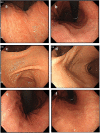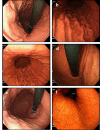Diagnostic Accuracy of H. pylori Status by Conventional Endoscopy: Time-Trend Change After Eradication and Impact of Endoscopic Image Quality
- PMID: 35155488
- PMCID: PMC8831333
- DOI: 10.3389/fmed.2021.830730
Diagnostic Accuracy of H. pylori Status by Conventional Endoscopy: Time-Trend Change After Eradication and Impact of Endoscopic Image Quality
Abstract
Aim: To assess the time trend of diagnostic accuracy of pre- and post-eradication H. pylori status and interobserver agreement of gastric atrophy grading.
Methods: A series 100 of conventional endoscopic image sets taken from subjects undergoing gastric cancer screening at a polyclinic were evaluated by 5 experienced assessors. Each assessor independently examined endoscopic findings according to the Kyoto classification and then determined the H. pylori status (never, current, or past infected). Gastric atrophy was assessed according to the Kimura-Takemoto classification and classified into 3 grades (none/mild, moderate, or severe). The image series that ≥3 assessors considered to have good quality were arbitrarily defined as high-quality image (HQI) series, and the rest were defined as low-quality image (LQI) series.
Results: The overall diagnostic accuracy of H. pylori status was 83.0%. It was lowest in subjects with current infection (54%), gradually increased at 1 year (79%, P < 0.001) and 3 years (94.0%, P = 0.002), but then did not significantly change at 5 years (91.0%, P = 0.420) after eradication. The rate of LQI series was 28%. The overall diagnostic accuracy of H. pylori status dropped from 88.9% to 67.9% (P < 0.001), and the mean kappa value on gastric atrophy grading dropped from 0.730 to 0.580 (P = 0.002) in the HQI and LQI series, respectively.
Conclusions: Diagnostic accuracy of H. pylori status increased over time after eradication. LQI series badly affected the diagnostic accuracy of H. pylori status and the level of agreement when grading gastric atrophy.
Keywords: Helicobacter pylori; Kimura-Takemoto classification; Kyoto classification; endoscopic diagnosis; gastric atrophy; interobserver agreement.
Copyright © 2022 Quach, Aoki, Iga, Le, Kawamura, Yamashita, Tanaka, Yoshihara and Hiyama.
Conflict of interest statement
The authors declare that the research was conducted in the absence of any commercial or financial relationships that could be construed as a potential conflict of interest.
Figures






Similar articles
-
Combination of artificial intelligence endoscopic diagnosis and Kimura-Takemoto classification determined by endoscopic experts may effectively evaluate the stratification of gastric atrophy in post-eradication status.DEN Open. 2024 Nov 12;5(1):e70029. doi: 10.1002/deo2.70029. eCollection 2025 Apr. DEN Open. 2024. PMID: 39534404 Free PMC article.
-
Helicobacter pylori eradication improved the Kyoto classification score on endoscopy.JGH Open. 2020 May 29;4(5):909-914. doi: 10.1002/jgh3.12360. eCollection 2020 Oct. JGH Open. 2020. PMID: 33102763 Free PMC article.
-
Interobserver and intraobserver agreement for gastric mucosa atrophy.BMC Gastroenterol. 2015 Aug 4;15:95. doi: 10.1186/s12876-015-0327-x. BMC Gastroenterol. 2015. PMID: 26239636 Free PMC article.
-
Endoscopic appearances of gastric mucosa in different endoscopic models according to H. pylori infection status.JGH Open. 2024 Sep 21;8(9):e70028. doi: 10.1002/jgh3.70028. eCollection 2024 Sep. JGH Open. 2024. PMID: 39310671 Free PMC article. Review.
-
Endoscopic Kyoto classification of Helicobacter pylori infection and gastric cancer risk diagnosis.World J Gastroenterol. 2020 Feb 7;26(5):466-477. doi: 10.3748/wjg.v26.i5.466. World J Gastroenterol. 2020. PMID: 32089624 Free PMC article. Review.
References
LinkOut - more resources
Full Text Sources
Miscellaneous

